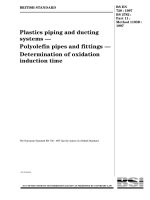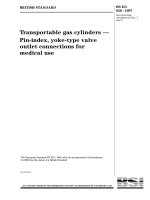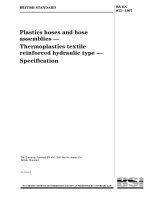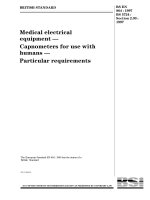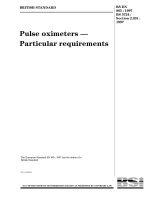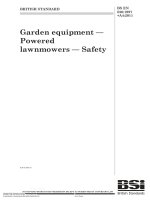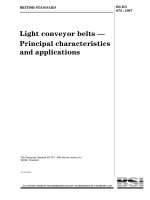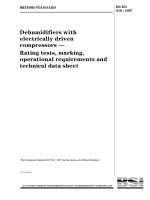Bsi bs en 01362 1997
Bạn đang xem bản rút gọn của tài liệu. Xem và tải ngay bản đầy đủ của tài liệu tại đây (116.71 KB, 20 trang )
BRITISH STANDARD
Identification card systems Ð
Device interface
characteristics Ð
Classes of device interfaces
The European Standard EN 1362 : 1997 has the status of a
British Standard
ICS 35.240.15
NO COPYING WITHOUT BSI PERMISSION EXCEPT AS PERMITTED BY COPYRIGHT LAW
|
|
|
|
|
|
|
|
|
|
|
|
|
|
|
|
|
|
|
|
|
|
|
|
|
|
|
|
|
|
|
|
|
|
|
|
|
|
|
|
|
|
|
|
|
|
|
|
|
|
|
|
|
|
|
|
|
|
|
|
|
|
|
|
|
|
|
|
|
|
|
|
|
|
|
|
|
|
|
|
|
|
|
|
|
|
|
|
|
|
|
|
|
|
|
|
|
|
|
|
|
|
|
|
|
|
|
|
|
|
|
|
|
|
|
|
|
|
|
|
|
|
|
|
|
|
|
|
|
BS EN
1362 : 1997
BS EN 1362 : 1997
Committees responsible for this
British Standard
The preparation of this British Standard was entrusted to Technical Committee
IST/17, Identification cards and related devices, upon which the following bodies
were represented:
APACS (Barclaycard)
APACS (Co-operative Bank)
APACS (Lloyds Bank)
APACS (Midland Bank)
APACS (National Westminster Bank)
Association for Payment Clearing Services (APACS)
BT Laboratories
Cellnet
Consumer Policy Committee of BSI
GPT Card Technology
Mondex International
Motorola Ltd.
Rochford Thompson Equipment
Shell UK
Stationery Office
Thorn Transit Systems International
Vodafone Ltd.
Westinghouse Cubic Ltd.
This British Standard, having
been prepared under the
direction of the DISC Board, was
published under the authority of
the Standards Board and comes
into effect on
15 July 1997
BSI 1997
Amendments issued since publication
Amd. No.
The following BSI references
relate to the work on this
standard:
Committee reference IST/17
Draft for comment 94/643125 DC
ISBN 0 580 27662 7
Date
Text affected
BS EN 1362 : 1997
Contents
Committees responsible
National foreword
Foreword
Text of EN 1362
BSI 1997
Page
Inside front cover
ii
2
3
i
BS EN 1362 : 1997
National foreword
This British Standard has been prepared by Technical Committee IST/17 and is the
English language version of EN 1362 : 1997 Identification card systems Ð Device
interface characteristics Ð Classes of device interfaces, published by the European
Committee for Standardization (CEN).
This British Standard is published under the direction of the DISC Board whose
Technical Committee IST/17 has the responsibility to:
± aid enquirers to understand the text;
± present to the responsible international/European committee any enquiries on
interpretation, or proposals for change, and keep UK interests informed;
± monitor related international and European developments and promulgate them
in the UK.
Important note. EN 1362 : 1997 was produced as a result of international discussions
by CEN Technical Committee TC 224 in which the UK took an active part. The UK
voted against the draft of EN 1362 : 1997 on the basis that Technical Committee IST/17
could foresee no practical application for the standard. However, the terms of the UK's
membership in CEN require BSI to publish this standard.
Any enquiries about this British Standard should be directed to the Secretary of
Technical Committee IST/17 at BSI.
NOTE. International and European Standards, as well as overseas standards, are available from
Customer Services, BSI, 389 Chiswick High Road, London, W4 4AL.
Compliance with a British Standard does not of itself confer immunity
from legal obligations.
Summary of pages
This document comprises a front cover, an inside front cover, pages i and ii, the
EN title page, pages 2 to 14, an inside back cover and a back cover.
ii
BSI 1997
EN 1362
EUROPEAN STANDARD
NORME EUROPÊENNE
EUROPẰISCHE NORM
January 1997
ICS 35.240.15
Descriptors: Telecommunication, telecommunication terminals, magnetic cards, interfaces, characteristics, classifications,
dimensions, messages, codification
English version
Identification card systems Ð
Device interface characteristics Ð
Classes of device interfaces
SysteÁmes de cartes d'identification Ð
CaracteÂristiques d'interface des terminaux Ð
Classes d'interfaces
Identifikationskartensysteme Ð Eigenschaften von
EndgeraÈteschnittstellen Ð Schnittstellenklassen
This European Standard was approved by CEN on 1996-12-25. CEN members are
bound to comply with the CEN/CENELEC Internal Regulations which stipulate the
conditions for giving this European Standard the status of a national standard
without any alteration.
Up-to-date lists and bibliographical references concerning such national standards
may be obtained on application to the Central Secretariat or to any CEN member.
This European Standard exists in three official versions (English, French, German).
A version in any other language made by translation under the responsibility of a
CEN member into its own language and notified to the Central Secretariat has the
same status as the official versions.
CEN members are the national standards bodies of Austria, Belgium, Denmark,
Finland, France, Germany, Greece, Iceland, Ireland, Italy, Luxembourg, Netherlands,
Norway, Portugal, Spain, Sweden, Switzerland and United Kingdom.
CEN
European Committee for Standardization
Comite EuropeÂen de Normalisation
EuropaÈisches Komitee fuÈr Normung
Central Secretariat: rue de Stassart 36, B-1050 Brussels
1997 Copyright reserved to CEN members
Ref. No. EN 1362 : 1997 E
Page 2
EN 1362 : 1997
Foreword
This European Standard has been prepared by
Technical Committee CEN/TC 224, Machine-readable
cards, related device interfaces and operations, the
secretariat of which is held by AFNOR.
This European Standard shall be given the status of a
national standard, either by publication of an identical
text, or by endorsement, at the latest by July 1997, and
conflicting national standards shall be withdrawn at
the latest by July 1997.
According to the CEN/CENELEC Internal Regulations,
the national standards organizations of the following
countries are bound to implement this European
Standard: Austria, Belgium, Denmark, Finland, France,
Germany, Greece, Iceland, Ireland, Italy, Luxembourg,
Netherlands, Norway, Portugal, Spain, Sweden,
Switzerland and the United Kingdom.
Contents
Page
2
3
3
6
6
7
7
7
Foreword
1 Scope
2 Normative references
3 Definitions and abbreviations
3.1 Definitions
3.2 Abbreviations
4 Organization of interface characteristics
5 Card interface
5.1 Card interface: physical dimensions
characteristics
5.2 Card interface: technology characteristics
5.3 Card interface: communication characteristics
5.4 Card interface: data characteristics
5.5 Basic card interface coding
6 Data communication interface
6.1 Data communication interface: physical
characteristics
6.2 Data communication interface: technology
characteristics
6.3 Data communication interface: communication
characteristics
6.4 Data communication interface: message
characteristics
6.5 Basic data communication interface coding
7 Security module interface
8 Human interface
Annex
A (informative) Examples of interface coding
A.1 Case 1
A.2 Case 2
7
8
8
8
8
10
10
11
11
12
12
14
14
14
14
14
BSI 1997
Page 3
EN 1362 : 1997
1 Scope
This European Standard specifies mandatory and
optional interfaces between devices and machine
readable cards, as well as other interfaces only to the
extent that they are related to the processing of the
machine readable card. It specifies the characteristics
of each particular interface, and provides the means,
through the use of bitmap coding, of readily identifying
the capabilities of devices in order to ensure the
compatibility between specific devices and cards. As
far as technical specifications are concerned, it refers
to other existing standards.
EN 27810
EN 27811-2
EN 27811-4
2 Normative references
EN 27811-5
This European Standard incorporates by dated or
undated reference, provisions from other publications.
These normative references are cited at the
appropriate places in the text and the publications are
listed hereafter. For dated references, subsequent
amendments to or revisions of any of these
publications apply to this European Standard only
when incorporated in it by amendment or revision. For
undated references the latest edition of the publication
referred to applies.
EN 27813
Identification card systems Ð
Telecommunications integrated
circuit(s) cards and terminals Ð
Part 2: Security framework
EN 726-3
Identification card systems Ð
Telecommunications integrated
circuit(s) cards and terminals Ð
Part 3: Application independent
card requirements
EN 726-4
Identification card systems Ð
Telecommunications integrated
circuit(s) cards and terminals Ð
Part 4: Application independent
card related terminal
requirements
prEN 753-1
Identification card systems Ð
Intersector thin flexible cards Ð
Part 1: General technical
specifications
prEN 753-2
Identification card systems Ð
Intersector thin flexible cards Ð
Part 2: Magnetic recording
technique
EN ISO/IEC 10536-1 Identification cards Ð
Contactless integrated circuit(s)
cards Ð Part 1: Physical
characteristics
(ISO/IEC 10536-1 : 1992)
EN 24909
Bank cards Ð Magnetic stripe
data content for track 3
(ISO 4909 : 1987)
EN 27816-1 : 1989
EN 726-2
BSI 1997
EN 27816-2 : 1989
EN 27816-3 : 1992
EN 28583
ENV 1375-1
prENV 1375-2
ETS 300 115
Identification cards Ð Physical
characteristics
(ISO 7810 : 1985)
Identification cards Ð Recording
technique Ð
Part 2: Magnetic stripe
(ISO 7811-2 : 1988)
Identification cards Ð Recording
technique Ð
Part 4: Location of read-only
magnetic tracks Ð Tracks 1
and 2
(ISO 7811-4 : 1985)
Identification cards Ð Recording
technique Ð
Part 5: Location of read-write
magnetic track Ð Track 3
(ISO 7811-5 : 1985)
Identification cards Ð Financial
transaction cards
(ISO 7813 : 1990)
Identification cards Ð Integrated
circuit(s) cards with contacts Ð
Part 1: Physical characteristics
(ISO 7816-1 : 1987)
Identification cards Ð Integrated
circuit(s) cards with contacts Ð
Part 2: Dimension and location
of the contacts
(ISO 7816-2 : 1988)
Identification cards Ð Integrated
circuit(s) cards with contacts Ð
Part 3: Electronic signals and
transmission protocols
(ISO/IEC 7816-3 : 1989)
Financial transaction card
originated messages Ð
Interchange message
specification
(ISO 8583 : 1993)
Identification card systems Ð
Intersector integrated circuit(s)
card additional format Ð
Part 1: ID-000 card size and
physical characteristics
Identification card systems Ð
Intersector integrated circuit(s)
card additional format Ð
Part 2: ID-00 card size and
physical characteristics
Attachments to the Public
Switched Telephone Network
(PSTN); Category II attachment
requirements for 300 bits per
second duplex modems
standardized for use on the
PSTN (NET 21)
Page 4
EN 1362 : 1997
ETS 300 116
ETS 300 117
ETS 300 118
ETS 300 175-2
ETS 300 175-3
ETS 300 175-4
ETS 300 175-5
ETS 300 175-9
ETS 300 331
Attachments to the Public
Switched Telephone Network
(PSTN); Category II attachment
requirements for 1200 bits per
second duplex modems
standardized for use on the
PSTN (NET 22)
Attachments to the Public
Switched Telephone Network
(PSTN); Category II attachment
requirements for 2400 bits per
second duplex modems
standardized for use on the
PSTN (NET 23)
Attachments to the Public
Switched Telephone Network
(PSTN); Category II attachment
requirements for 1200 bits per
second half duplex and
1200/75 bits per second
asymmetrical duplex modems
standardized for use on the
PSTN (NET 24)
Radio Equipment and systems
(RES) Ð Digital European
Cordless Telecommunications
(DECT) Common Interface Ð
Part 2: Physical layer
Radio Equipment and systems
(RES) Ð Digital European
Cordless Telecommunications
(DECT) Common Interface Ð
Part 3: Medium access control
layer
Radio Equipment and systems
(RES) Ð Digital European
Cordless Telecommunications
(DECT) Common Interface Ð
Part 4: Data link control layer
Radio Equipment and systems
(RES) Ð Digital European
Cordless Telecommunications
(DECT) Common Interface Ð
Part 5: Network layer
Radio Equipment and systems
(RES) Ð Digital European
Cordless Telecommunications
(DECT) Common Interface Ð
Part 9: Public access profile
Radio Equipment and systems
(RES) Ð Digital European
Cordless Telecommunications
(DECT) authentication module
specifications
I-ETS 300 021
I-ETS 300 022-1
I-ETS 300 022-2
I-ETS 300 023
I-ETS 300 024
I-ETS 300 025
I-ETS 300 026
I-ETS 300 027
I-ETS 300 028
European digital cellular
telecommunication system
(Phase 1) Ð Mobile Station Ð
Base Station System (MS-BSS)
interface data link layer
specification (GSM 04.06)
European digital cellular
telecommunications system
(Phase 1) Ð Mobile radio
interface layer 3 specification
(GSM 04.08)
European digital cellular
telecommunications system
(Phase 1) Ð Mobile radio
interface layer 3 specification Ð
Part 2: DCS extension
(GSM 04.08-DCS)
European digital cellular
telecommunications system
(Phase 1) Ð Point-to-point short
message service support on
mobile radio interface
(GSM 04.11)
European digital cellular
telecommunications system
(Phase 1) Ð Short Message
Service Cell Broadcast (SMSCB)
support on the mobile radio
interface (GSM 04.12)
European digital cellular
telecommunications system
(Phase 1) Ð Rate adaptation on
the Mobile Station Ð Base
Station System (MS-BSS)
interface (GSM 04.21)
European digital cellular
telecommunications system
(Phase 1) Ð Radio Link Protocol
(RLP) for data and telematic
services on the Mobile Station Ð
Base Station System (MS-BSS)
interface and the Base Station
System Ð Mobile Services
Switching Centre (BSS-MSC)
interface (GSM 04.22)
European digital cellular
telecommunications system
(Phase 1) Ð Mobile radio
interface layer 3 supplementary
services specifications Formats
and coding (GSM 04.80)
European digital cellular
telecommunications system
(Phase 1) Ð Mobile radio
interface layer 3 call offering
supplementary services
specification (GSM 04.82)
BSI 1997
Page 5
EN 1362 : 1997
I-ETS 300 029
I-ETS 300 030
I-ETS 300 031
I-ETS 300 032
I-ETS 300 033-1
I-ETS 300 033-2
I-ETS 300 034-1
I-ETS 300 034-2
I-ETS 300 045-1
I-ETS 300 045-2
ISO 2110
BSI 1997
European digital cellular
telecommunications system
(Phase 1) Ð Mobile radio
interface layer 3 restriction
supplementary services
specification (GSM 04.88)
European digital cellular
telecommunications system
(Phase 1) Ð Multiplexing and
multiple access on the radio path
(GSM 05.02)
European digital cellular
telecommunications system
(Phase 1) Ð Channel coding
(GSM 05.03)
European digital cellular
telecommunications system
(Phase 1) Ð Modulation
(GSM 05.04)
European digital cellular
telecommunications system
(Phase 1) Ð Radio transmission
and reception (GSM 05.05)
European digital cellular
telecommunications system
(Phase 1) Ð Radio transmission
and reception Ð
Part 2: DCS extension
(GSM 05.05-DCS)
European digital cellular
telecommunications system
(Phase 1) Ð Radio sub-system
link control (GSM 05.08)
European digital cellular
telecommunications system
(Phase 1) Ð Radio sub-system
link control Ð
Part 2: DCS extension
(GSM 05.08-DCS)
European digital cellular
telecommunications system
(Phase 1) Ð Subscriber Identity
Module Ð Mobile Equipment
(SIM-ME) interface specification
(GSM 11.11)
European digital cellular
telecommunications system
(Phase 1) Ð Subscriber Identity
Module Ð Mobile Equipment
(SIM-ME) interface
specification Ð
Part 2: DCS extension
(GSM 11.11-DCS)
Information technology Ð Data
communication Ð 25-pole
DTE/DCE interface connector
and contact number assignments
ISO 4902
Information technology Ð Data
communication Ð 37-pole
DTE/DCE interface connector
and contact number assignments
ISO/IEC 7816-4
Identification cards Ð Integrated
circuit(s) cards with contacts Ð
Part 4: Interindustry commands
for interchange
ISO/IEC 8473-1
Information technology Ð
Protocol for providing the
connectionless-mode network
service Ð
Part 1: Protocol specification
ISO/IEC /DIS 8473-2 Information technology Ð
Protocol for providing the
connectionless-mode network
service Ð
Part 2: Provision of the
underlying service by an
ISO/IEC 8802 subnetwork
ISO/IEC TR 8802-1 Information technology Ð
Telecommunications and
information exchange between
systems Ð Local and
metropolitan area networks Ð
Specific requirements Ð
Part 1: Overview of Local Area
Network Standards
ISO/IEC 8802-3
Information technology Ð Local
and metropolitan area networks
Ð Part 3: Carrier sense multiple
access with collision detection
(CSMA/CD) access method and
physical layer specifications
ISO/IEC 8802-4
Information processing systems
Ð Local area networks Ð
Part 4: Token-passing bus access
method and physical layer
specifications
ISO/IEC 8802-5
Information processing systems
Ð Local and metropolitan area
networks Ð
Part 5: Token ring access method
and physical layer specifications
ISO 9542
Information processing systems
Ð Telecommunications and
information exchange between
systems Ð End system to
intermediate system routeing
exchange protocol for use in
conjunction with the Protocol for
providing the
connectionless-mode network
service
(ISO 8473)
Page 6
EN 1362 : 1997
ISO 9992-2
Financial transaction cards Ð
Messages between the integrated
circuit card and the card
accepting device Ð
Part 2: Functions, messages
(commands and responses), data
elements and structures
ISO/IEC 10536-2
Identification cards Ð
Contactless integrated circuit(s)
cards Ð
Part 2: Dimensions and location
of coupling areas
ISO/IEC 10536-3
Identification cards Ð
Contactless integrated circuit(s)
cards Ð
Part 3: Electronic signals and
reset procedures
ISO/IEC 11694-2
Identification cards Ð Optical
memory cards Ð Linear
recording method Ð
Part 2: Dimensions and location
of the accessible optical area
ISO/IEC 11694-3
Identification cards Ð Optical
memory cards Ð Linear
recording method Ð
Part 3: Optical properties and
characteristics
ISO/IEC /DIS 11694-4 Identification cards Ð Optical
memory cards Ð Linear
recording method Ð
Part 4: Logical data structures
ITU-T
Basic user-network interface Ð
recommendation
Layer 1 specification
I.430
ITU-T
List of definitions for
recommendation
interchange circuits between data
V.24
terminal equipment (DTE) and
data circuit-terminating
equipment (DCE)
ITU-T
Electrical characteristics for
recommendation
unbalanced double-current
V.28
interchange circuits
CCITT
Interface between data terminal
recommendation
equipment and data
X.21
circuit-terminating equipment
for synchronous operation on
public data networks
ITU-T
Interface between data terminal
recommendation
equipment (DTE) and data
X.25
circuit-terminating equipment
(DCE) for terminals operating in
the packet mode and connected to
public data networks by
dedicated circuit
CCITT
recommendation
X.26
CCITT
recommendation
X.27
ITU-T
recommendation
X.28
ITU-T
recommendation
X.31
ITU-T
recommendation
X.32
Electrical characteristics for
unbalanced double-current
interchange circuits for general
use with integrated equipment in
the field of data communications
Electrical characteristics for
balanced double-current
interchange circuits for general
use with integrated equipment in
the field of data communications
DTE/DCE interface for a
start-stop mode data terminal
equipment accessing the packet
assembly/disassembly facility
(PAD) in a public data network
situated in the same country
Support of packet mode terminal
equipment by an ISDN
Interface between DTE and DCE
for terminals operating in the
packet mode and accessing a
packet switched public data
network through a public
switched telephone network or an
integrated services digital
network or a circuit switched
public data network
3 Definitions and abbreviations
NOTE. The definitions in this inter-industry standard are
independent of any specific application.
3.1 Definitions
For the purposes of this standard, the following
definitions apply:
3.1.1 interface
The logical and/or physical connection between a
component or sub-assembly in a terminal and an
external entity, e.g. a card, a secure application
module, a human being or a communication link
during a transaction process. An interface may be
established for all or part of a transaction process and
has or may have an interaction with the card, or with
its technology(ies), or with its operation.
3.1.2 security module
A module intended to contain algorithm(s), related
keys, security procedures and information to protect
an application in such a way that unauthorized access
is not possible. In order to achieve this, the module
shall be physically, electrically and logically protected.
3.1.3 interface device
A communication device to which a card is logically
connected during the transaction process.
BSI 1997
Page 7
EN 1362 : 1997
3.1.4 personal identification number
A code or password that the customer possesses for
verification of identity.
3.1.5 basic interface characteristic
A two digit code representing one or more options
pertaining to a characteristic for a specific interface.
3.1.6 elementary interface code
A sequence of basic interface characteristics in a
particular order.
3.1.7 global interface code
A set of elementary interface codes.
3.1.8 electrical interface
An interface with galvanic contacts.
3.2 Abbreviations
ATR:
BPS:
CAD:
DECT:
DCE:
DCS:
DTE:
GSM:
HDLC:
HICO:
ICC:
LOCO:
PIN:
SM:
Answer to Reset
Bits per second
Card accepting device
Digital European Cordless
Telecommunications
Data circuit-terminating equipment
Digital cellular system
Data terminal equipment
Global System for Mobile Communications
High level data link control
High coercivity
Integrated circuit card
Low coercivity
Personal identification number
Security module
4 Organization of interface
characteristics
The following types of interface may be established:
± card interface: an interface between a CAD and a
machine readable card. A terminal conforming to
this standard shall provide the ability to establish a
card interface. This interface is mandatory;
± security module interface: an interface between a
CAD and a security module. A terminal conforming
to this standard may provide the ability to establish
an SM interface. This interface is optional;
± human interface : an interface between a CAD and
a person. A terminal conforming to this standard
may provide the ability to establish a human
interface. This interface is optional;
BSI 1997
± data communication interface : an interface
between a CAD and another computing equipment.
A terminal conforming to this standard may provide
the ability to establish a communication network
interface. This interface is optional.
A terminal may support more than one type of
interface and more than one interface of the same
type.
An interface is described according to one or more
basic interface characteristics. A basic interface
characteristic is a two hexadecimal digit code
representing one or more options pertaining to this
characteristic. An elementary interface code is derived
from the selection of one available code for each basic
interface characteristic in sequence. The combination
of all the elementary interface codes determines the
global interface code of this interface.
The global interface code of all the interfaces of a CAD
shall be retrievable from the CAD. It can be made
readable at one of the interfaces of the CAD, or on the
manufacturer label of the equipment. The global
interface code of all the interfaces shall be read in the
following order : card interfaces, data communication
interfaces, security module interfaces and human
interfaces. If one is not present on the CAD, the
code 00 shall appear in its place.
The general code shall therefore appear as follows:
C(card interface global interface code) - D(data
communication interface global interface code) S(security module interface global interface code) H(human interface global interface code).
5 Card interface
A card interface is described according to the
following characteristics:
± physical dimensions characteristics;
± technology characteristics;
± communication characteristics;
± message and data characteristics.
5.1 Card interface: physical dimensions
characteristics
The card interface physical dimensions, as shown in
table 1, are supported by this European Standard.
Table 1. Card types, reference standards
Card type
Reference standard
ID000
ID00
ID1
ID2
ID3
TFC0
TFC1
TFC5
ENV 1375-1
prENV 1375-2
EN 27810
EN 27810
EN 27810
prEN 753-1
prEN 753-1
prEN 753-1
Page 8
EN 1362 : 1997
5.2 Card interface: technology characteristics
5.2.1 Magnetic
The following types of magnetic cards are supported in
this European Standard:
± in accordance with EN 27811-2, EN 27811-4 and
EN 27811-5 on magnetic stripes with track 1 and/or
track 2 and/or track 3;
± in accordance with prEN 753-2 for TFC0, TFC1 and
TFC5 cards magnetic tracks.
5.2.2 Electro-magnetic
The following types of electro-magnetic cards are
supported in this European Standard:
± in accordance with ISO/IEC 11694-2 for optical
memory cards technologies;
± in accordance with ISO/IEC 10536-2 and
ISO/IEC 10536-3 for capacitive and/or inductive
technologies;
± reserved for future use for radiocommunication
technologies.
5.2.3 Electrical/galvanic
The following types of card interface electrical
technologies are supported in this European Standard:
± in accordance with EN 27816-1 : 1989,
EN 27816-2:1989, clauses 3 to 5 of EN 27816-3:1992;
± in accordance with EN 726-3.
5.3 Card interface: communication
characteristics
5.3.1 Passive communication
The following types of passive communication
characteristics are supported in this European
Standard:
± in accordance with EN 27811-2, EN 27811-4 and
EN 27811-5 on magnetic stripes with track 1 and/or
track 2 and/or track 3;
± in accordance with prEN 753-2 on magnetic stripes
with central track and/or track 4;
± in accordance with ISO/IEC 11694-3 for optical
memory cards.
5.3.2 Active communication
5.3.2.1 Synchronous transmission
The following types of synchronous transmission
modes are supported in this European Standard:
± in accordance with 5.2 and 6.2 of
EN 27816-3 : 1992 (synchronous integrated circuit
card transmission).
5.3.2.2 Asynchronous transmission
The following types of asynchronous transmission
modes are supported in this European Standard:
± character mode transmission according to the
T=0 IC card protocol as described in clauses 6 and 8
of EN 27816-3 : 1992;
± block mode transmission according to the T=1 IC
card protocol as described in clauses 6 and 9 of
EN 27816-3 : 1992;
± parameters and protocol type selection (PTS)
supported as described in clause 7 of
EN 27816-3 : 1992;
± reserved for future use for duplex transmission.
5.4 Card interface: data characteristics
5.4.1 Data for passive cards technologies
The following data structures are supported in this
European Standard:
± in accordance with EN 27813 for data on magnetic
card tracks 1 and 2;
± in accordance with EN 24909 for data on magnetic
card track 3;
± in accordance with ISO/IEC/DIS 11694-4 for data on
optical memory cards;
± reserved for future use for data on magnetic card
tracks TFC0, TFC1, and TFC5.
5.4.2 Commands and data for active card
technologies
The following commands and data structures are
supported in this European Standard:
± in accordance with ISO/IEC 7816-4 : all the
supported messages are implemented as described in
ISO/IEC 7816-4;
± in accordance with ISO 9992-2 for banking
applications: all the supported messages are
implemented as described in ISO 9992-2;
± in accordance with EN 726-3 for
telecommunication applications: all the supported
messages are implemented as described in EN 726-3;
± in accordance with ETS 300 331 for DECT
telecommunication applications: all the supported
messages are implemented as described in
ETS 300 331;
± in accordance with I-ETS 300 045-1 for GSM
telecommunication applications (and
I-ETS 300 045-2 for DCS extension applications): all
the supported messages are implemented as
described in ETS 300 045-1 and I-ETS 300 045-2;
± proprietary messages: when proprietary messages
are supported by the interface, they shall not be
standardized, but this situation is included in the
coding of the interface characteristics.
5.5 Basic card interface coding
A coding is specified in this standard in order to
identify the interface characteristics. It uses a bitmap
type of coding for all the characteristics, with some
extension mechanisms for extra bytes to be added if
needed.
It shall be the responsibility of every sector or
application to define how such a data element is used,
if needed.
The coding is done with at least 1 byte for each
characteristic. The bit b8 (most significant bit) of a
byte indicates the presence of a subsequent byte ; b8 is
named `Extension' in figures 1 to 8. The bit b7 of the
first byte indicates a proprietary usage of this
characteristic ; b7 is named `Proprietary' in
figures 1 to 8. When an option is supported at the
interface, the corresponding bit in the interface
characteristics coding shall be set to 1.
BSI 1997
Page 9
EN 1362 : 1997
5.5.1 Coding of the physical dimensions characteristics
The following coding shall be used for the physical dimensions characteristics:
Extension
Proprietary ID1
TFC1
ID000
ID00
TFC0
TFC5
RFU
RFU
RFU
RFU
RFU
Figure 1. Coding of the first byte
Extension
ID2
ID3
Figure 2. Coding of the second byte
Example of values for one single characteristic:
± 20 for ID1 capability;
± 08 for ID000 capability;
± 8040 for ID2 capability.
5.5.2 Coding of the technological characteristics
The following coding shall be used for technological characteristics:
Extension
Proprietary Electrical
LOCO
magnetic
HICO
magnetic
Optical
Inductive
Capacitive
RFU
RFU
RFU
RFU
RFU
Asynchronous
T=0
PTS
RFU
RFU
Track 4
prEN 753-2
Central
RFU
track
prEN 753-2
RFU
Figure 3. Coding of the first byte
Extension
Radio
RFU
Figure 4. Coding of the second byte
Examples of values for one single characteristic:
± 20 for electrical/galvanic capability;
± 08 for high coercivity magnetic capability;
± 8040 for radio capability.
5.5.3 Coding of the communication characteristics
The following coding shall be used for the communication characteristics:
Extension
Proprietary Synchronou Asynchronous
s electrical T=1
Figure 5. Coding of the first byte
Extension
Track 1
Track 2
EN 27811-4 EN 27811-4
Figure 6. Coding of the second byte
BSI 1997
Track 3
EN 27811-5
Page 10
EN 1362 : 1997
Example of values for some characteristics:
± 08 for asynchronous capability with protocols T=0;
± 1 C for asynchronous capabilities with both protocols T=0 and T=1 and PTS;
± 9C20 for asynchronous capabilities with protocols T=0 and T=1, PTS and ISO track 2 magnetic
capability.
NOTE. The T=0 (T=1 respectively) bit of the first byte set to 1 means that the interface is able to support the T=0 (T=1 respectively)
standard protocol as defined in EN 27816-3 : 1992 clause 8 (clause 9 respectively) of EN 27816-3 : 1992.
5.5.4 Coding of the data characteristics
The following coding shall be used for the data characteristics:
Extension
Proprietary ISO/IEC
7816-4
EN 726-2
ISO 9992-2
I-ETS
300 045-1
I-ETS
300 045-2
ETS
300 331
Track 3
EN 24909
RFU
RFU
RFU
RFU
Figure 7. Coding of the first byte
Extension
Track 1
EN 27813
Track 2
EN 27813
Figure 8. Coding of the second byte
Example values for some characteristics:
± 20 for IC card intersector data capabilities;
± 8020 for magnetic card track 2 data capabilities;
± A120 for IC card intersector and DECT data capabilities and magnetic card track 2
data capabilities.
6 Data communication interface
The data communication interface is described
according to the following characteristics :
± physical characteristics;
± technology characteristics;
± communication characteristics;
± message and data characteristics.
6.1 Data communication interface: physical
characteristics
The following types of connectors are supported in
this European Standard:
± RS232 9 way D-type Male/female in accordance
with ISO 4902;
± RS232 25 way D-type Male/female in accordance
with ISO 2110;
± BNC/TNC (Coaxial cable);
± RJ11 jack plug (4 wires);
± RJ12 jack plug (6 wires);
± RJ45 jack plug (8 wires).
BSI 1997
Page 11
EN 1362 : 1997
6.2 Data communication interface : technology
characteristics
The following types of data communication interface
technologies are supported in this European Standard :
a) electrical link.
The following mode of electrical links are supported
in this European Standard:
± 300 bps V.21 modem:
such a connection shall
comply with ETS 300 115;
± 1200 bps V.22 modem: such a connection shall
comply with ETS 300 116;
± 2400 bps V.22bis
such a connection shall
modem :
comply with ETS 300 117;
± 1200/75 bps V.23
such a connection shall
modem :
comply with ETS 300 118;
± V.28 :
such a connection shall
comply with ITU-T
recommendation V.28;
± X.26 :
such a connection shall
comply with CCITT
recommendation X.26;
± X.27 :
such a connection shall
comply with CCITT
recommendation X.27;
± I.430 :
such a connection shall
comply with ITU-T
recommendation I.430;
± ISO/IEC 8802-3 :
such a connection shall
comply with
ISO/IEC 8802-3 physical
layer;
± ISO/IEC 8802-4 :
such a connection shall
comply with
ISO/IEC 8802-4 physical
layer;
± ISO/IEC 8802-5 :
such a connection shall
comply with
ISO/IEC 8802-5 physical
layer;
b) radio frequencies electromagnetic link.
The following mode of radio links are supported in
this European Standard:
± GSM link : such a connection shall comply with
I-ETS 300 030, I-ETS 300 031,
I-ETS 300 032, I-ETS 300 033-1,
I-ETS 300 034-1;
± DCS link : such a connection shall comply with
I-ETS 300 030, I-ETS 300 031,
I-ETS 300 032, I-ETS 300 033-2 (DCS
extension), I-ETS 300 034-2 (DCS
extension);
± DECT link :such a connection shall comply with
ETS 300 175-2;
BSI 1997
c) optical frequencies electromagnetic link: reserved
for future use;
d) proprietary links.
6.3 Data communication interface:
communication characteristics
The following types of data communication interface
communication characteristics (layer 2, layer 3 and
provisions for multiple networks interconnections) are
supported in this European Standard:
± V.24 for interchange between DTE and DCE;
± X.21 for synchronous dial-in access to a public
data network;
± HDLC (layer 2) point to point as described in
ITU-T recommendation X.25;
± X.25 (layers 2 and 3), in accordance with full ITU-T
recommendation X.25;
±X.28, in accordance with ITU-T recommendation
X.28, for asynchronous dial-in access to a public
data network;
± X.31 case A, in accordance with ITU-T
recommendation X.31, for access to a public data
network via an ISDN B-channel;
± X.31 case B, in accordance with ITU-T
recommendation X.31, for access to a public data
network via an ISDN D-channel;
± X.32, in accordance with ITU-T recommendation
X.32, for packet-mode terminals (dial-in access);
± GSM protocol implemented in accordance with
I-ETS 300 021 and I-ETS 300 022-1;
± DCS protocol implemented in accordance with
I-ETS 300 021 and I-ETS 300 022-2;
± DECT layers 2 and 3 implemented in accordance
with ETS 300 175-3, ETS 300 175-4 and ETS 300 175-5;
± ISO/IEC 8802-3 for protocols using a CSMA/CD
access method;
± ISO/IEC 8802-4 for protocols using a token-passing
bus access method;
± ISO/IEC 8802-5 for protocols using a token ring
access method;
± ISO/IEC/DIS 8473-2 for connectionless-mode
network services over an underlying
ISO/IEC 8802 sub-network;
± ISO 9542 for the routing aspects in a LAN/WAN
interconnection;
± proprietary communication characteristics.
Page 12
EN 1362 : 1997
6.4 Data communication interface: message
characteristics
The following types of data communication interface
message characteristics are supported in this European
Standard:
± banking messages supported in accordance with
EN 28583;
± GSM messages supported in accordance with
I-ETS 300 023, I-ETS 300 024, I-ETS 300 025,
I-ETS 300 026, I-ETS 300 027, I-ETS 300 028 and
I-ETS 300 029;
± DECT messages supported in accordance with
ETS 300 175-9;
± proprietary messages.
6.5 Basic data communication interface coding
A coding is defined in this standard in order to identify
the interface characteristics. It uses a bitmap type of
coding for all the characteristics, with some extension
mechanisms for extra bytes to be added if needed.
It shall be the responsibility of every sector or
application to define how such a data element is used,
if needed.
The coding is done with at least 1 byte for each
characteristic. The bit b8 (most significant bit) of a
byte indicates the presence of a subsequent byte; b8 is
named `Extension' in figures 9 to 17. The bit b7 of the
first byte indicates a proprietary usage of this
characteristic; b7 is named `Proprietary' in
figures 9 to 17. When an option is supported at the
interface, the corresponding bit in the interface
characteristics coding shall be set to 1.
BSI 1997
Page 13
EN 1362 : 1997
6.5.1 Coding of the physical characteristics
The following coding shall be used for the physical characteristics:
Extension
Proprietary
RS232
9 way
female
RS232
25 way
female
RS232
9 way
male
RS232
25 way
male
BNC/TNC
RFU
RJ45
RFU
RFU
RFU
RFU
Figure 9. Coding of the first byte
Extension
RJ11
RJ12
Figure 10. Coding of the second byte
6.5.2 Coding of the technological characteristics
The following coding shall be used for the technological characteristics:
Extension
Proprietary
ETS
300 115
ETS
300 116
ETS
300 117
ETS
300 118
X.26
X.27
ISO/IEC
8802-3
ISO/IEC
8802-4
ISO/IEC
8802-5
RFU
RFU
DECT
RFU
RFU
RFU
RFU
Figure 11. Coding of the first byte
Extension
V.28
I.430
Figure 12. Coding of the second byte
Extension
GSM
DCS
Figure 13. Coding of the third byte
6.5.3 Coding of the communication characteristics
The following coding shall be used for the communication characteristics of the data communication interface. In
the case of ISO/IEC 8802 LAN capabilities, the interworking capabilities shall be indicated with the subsequent
bits of the second byte. If none of the interworking bits are set to 1, this means that the equipment has no
interworking capability, and can be used in a stand alone LAN only.
Extension
Proprietary
V.24
X.21
HDLC
X.25
X.28
X.32
ISO/IEC
8802-3
ISO/IEC
8802-4
ISO/IEC
8802-5
ISO/IEC
Proprietary
8473-1
interworking
ISO/IEC/DIS
8473-2
ISO 9542
interworking
Figure 14. Coding of the first byte
Extension
X.31
case A
X.31
case B
Figure 15. Coding of the second byte
BSI 1997
Page 14
EN 1362 : 1997
Extension
GSM
DCS
DECT
RFU
RFU
RFU
RFU
RFU
RFU
RFU
Figure 16. Coding of the third byte
6.5.4 Coding of the message characteristics
The following coding shall be used for the message characteristics:
Extension
Proprietary
EN 28583
GSM
DECT
Figure 17. Coding of the first byte
7 Security module interface
NOTE. This clause is reserved for future use, when detailed
standards on security modules related to the processing of a
machine readable card are available.
8 Human interface
NOTE. This clause is reserved for future use, when detailed
standards on human interfaces related to the processing of a
machine readable card are available.
Annex A (informative)
Examples of interface coding
This annex gives some examples of coding for card
interfaces of a CAD.
A.1 Case 1
The card interface of a CAD which accepts integrated
circuit cards of the ID1 format following the standards
EN 27816-1 : 1989, EN 27816-2 : 1989,
EN 27816-3 : 1992 with T=0 and T=1 and PTS protocols,
ISO/IEC 7816-4, as well as magnetic cards with low
coercivity ISO track 2, all within the same card reader,
is coded as follows:
C 20-30-9C20-A020
A.2 Case 2
The card interfaces of a CAD which accepts integrated
circuit cards of the ID1 format following the standards
EN 27816-1 : 1989, EN 27816-2 : 1989,
EN 27816-3 : 1992 with T=0 and T=1 and PTS protocols,
ISO/IEC 7816-4 as well as magnetic cards with low
coercivity ISO track 2, within two different card
readers, one for the magnetic cards and one for the
integrated circuit cards, is coded as follows:
C 20-20-18-20
for the IC card reader
C 20-10-8020-8020 for the magnetic card reader
The code describing the card interfaces of such a CAD
should therefore read:
C(20-20-18-20) - C(20-10-8020-8020)
BSI 1997
blank
BSI
389 Chiswick High Road
London
W4 4AL
|
|
|
|
|
|
|
|
|
|
|
|
|
|
|
|
|
|
|
|
|
|
|
|
|
|
|
|
|
|
|
|
|
|
|
|
|
|
|
|
|
|
|
|
|
|
|
|
|
|
|
|
|
|
|
|
|
|
|
|
|
|
|
|
|
|
|
|
|
|
|
|
|
|
|
|
|
|
|
|
|
|
|
|
|
|
|
|
|
|
|
|
|
|
|
|
|
|
|
|
|
|
|
|
|
|
|
|
|
|
|
|
|
|
|
|
|
|
|
|
|
|
|
|
|
|
|
BSI Ð British Standards Institution
BSI is the independent national body responsible for preparing British Standards. It
presents the UK view on standards in Europe and at the international level. It is
incorporated by Royal Charter.
Revisions
British Standards are updated by amendment or revision. Users of British Standards
should make sure that they possess the latest amendments or editions.
It is the constant aim of BSI to improve the quality of our products and services. We
would be grateful if anyone finding an inaccuracy or ambiguity while using this
British Standard would inform the Secretary of the technical committee responsible,
the identity of which can be found on the inside front cover. Tel: 020 8996 9000.
Fax: 020 8996 7400.
BSI offers members an individual updating service called PLUS which ensures that
subscribers automatically receive the latest editions of standards.
Buying standards
Orders for all BSI, international and foreign standards publications should be
addressed to Customer Services. Tel: 020 8996 9001. Fax: 020 8996 7001.
In response to orders for international standards, it is BSI policy to supply the BSI
implementation of those that have been published as British Standards, unless
otherwise requested.
Information on standards
BSI provides a wide range of information on national, European and international
standards through its Library and its Technical Help to Exporters Service. Various
BSI electronic information services are also available which give details on all its
products and services. Contact the Information Centre. Tel: 020 8996 7111.
Fax: 020 8996 7048.
Subscribing members of BSI are kept up to date with standards developments and
receive substantial discounts on the purchase price of standards. For details of
these and other benefits contact Membership Administration. Tel: 020 8996 7002.
Fax: 020 8996 7001.
Copyright
Copyright subsists in all BSI publications. BSI also holds the copyright, in the UK, of
the publications of the international standardization bodies. Except as permitted
under the Copyright, Designs and Patents Act 1988 no extract may be reproduced,
stored in a retrieval system or transmitted in any form or by any means ± electronic,
photocopying, recording or otherwise ± without prior written permission from BSI.
This does not preclude the free use, in the course of implementing the standard, of
necessary details such as symbols, and size, type or grade designations. If these
details are to be used for any other purpose than implementation then the prior
written permission of BSI must be obtained.
If permission is granted, the terms may include royalty payments or a licensing
agreement. Details and advice can be obtained from the Copyright Manager.
Tel: 020 8996 7070.
